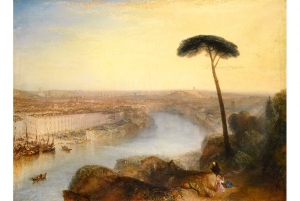|
Displaying items by tag: Preservation
Maine’s Portland Museum of Art (PMA) spent $2.3 million on a .57-acre plot of land surrounding Winslow Homer’s former studio on Prouts Neck in Scarborough to preserve the view the legendary painter had of the Atlantic Ocean. The U-shaped parcel of land, which surrounds the studio on either side, beginning at the small road that leads to it, runs down to Cliff Walk, a publicly owned waterfront space. According to the Portland Press Herald, it had belonged to Doris Homer, who died in 2009. She was the widow of the artist’s nephew.
The PMA restored Homer’s studio and has been conducting public tours of it since 2012.

One of the last great Turner masterpieces remaining in private hands will be the highlight of Sotheby’s London Evening sale of Old Master on 3rd December 2014. Painted in 1835 by Britain’s most celebrated artist, Rome, from Mount Aventine is among Turner’s most subtle and atmospheric depictions of the Italian city, a subject that captivated Turner for over twenty years. The large-scale oil painting is further distinguished by its exceptional state of preservation, as well as a prestigious and unbroken provenance, having changed hands for the only time in 1878, when it was acquired by the 5th Earl of Rosebery, later Prime Minister of Great Britain. The picture has remained in the Rosebery collection ever since and will be offered for sale with an estimate of £15-20 million.
Discussing the forthcoming sale, Alex Bell, Joint International Head and Co-Chairman of Sotheby’s Old Master Paintings Department said: “There are fewer than ten major Turners in private hands known today and this work must rank as one of the very finest.
Today, American Express and World Monuments Fund (WMF) announced $1.5 million in grant funding to support preservation efforts at nine historic sites. This is the second allocation from a $5 million, five-year grant to WMF from American Express to support the World Monuments Watch. Each of the nine locations was among the at-risk historic sites included on the 2014 Watch, announced in October 2013. American Express is founding sponsor of the Watch program.
Projects receiving funding are Pokfulam Village in Hong Kong (SAR), China; the churches of Saint Merri and Notre-Dame-de-Lorette in Paris, France; the Farnese Aviaries in Rome, Italy; Tenyuji Temple, Ogatsu, Japan; Fundidora Park in Monterrey, Mexico; the Güell Pavilions in Barcelona, Spain; the House of Wonders in Stone Town, Zanzibar, Tanzania; Battersea Power Station in London, United Kingdom; and Sulgrave Manor in Sulgrave, United Kingdom.
Maybe you have faded memories from many years or decades ago, of visiting an old house preserved as a museum — a stuffy, drab kind of place both physically and mentally. It felt like a place somewhat lost to time, stuck in a kind of historical coffin of its own design.
Fortunately, most historical house museums today, at least those of any renown, don’t fit that characterization. Even relic-filled places like Colonial Williamsburg have evolved with the times and especially the great strides made in historical preservation over the past couple decades, says Karen Daly, executive director of the Dumbarton House.
The Getty Conservation Institute in Los Angeles and the Salk Institute for Biological Studies in La Jolla are teaming up to develop careful approaches to help conserve one of Louis Kahn’s most iconic buildings -- the Salk Biological Institute campus plaza. Commissioned by Dr. Jonas Salk, inventor of the Polio vaccine, in 1959, the Salk Institute was completed in 1965 and remains one of the most celebrated pieces of modern architecture.
Constructed mainly of concrete and wood, the structure’s close proximity to the Pacific Ocean poses unique conservation challenges -- particularly for its unique teak “window walls,” one of the building’s defining architectural elements.
On Tuesday, August 12, Columbia University announced that New York-based architect Amale Andraos has been named the 13th dean of its Graduate School of Architecture, Preservation and Planning (GSAPP). Andraos, who was born in Beirut and has practiced in Montreal, Paris, and Rotterdam, has been an associate professor at the school since 2011. Andraos will assume the position on September 1, replacing Mark Wigley, who announced his retirement in September 2013. Andraos has also taught at Harvard University, Princeton University, Parsons School of Design, the University of Pennsylvania, the New York Institute of Technology, and the American University of Beirut.
Andraos is a principal at WORKac, the architecture firm that she runs with her husband, Dan Wood. Established in 2003, WORKac is interested in positing architecture at the intersection of the urban, the rural, and the natural.
German cultural commissioner Monika Grütters announced on Friday that the country would increase its cultural funding by €90 million for a total €1.3 billion ($1.76 billion) in allocated funds for 2014. The additional funding marks a seven percent increase over 2013.
Grütters said that the budgetary approval by the Bundestag secured, “a solid foundation for the development and creation of successful cultural-political [initiatives].” Among her major achievements since taking over the post from predecessor Bernd Neumann was the doubling of funds allocated to provenance research. The move followed the Gurlitt saga, which initiated a wealth of renewed public support for restitution efforts. Four million euros are now available annually to assist in such research.

Earlier this year, New York’s Museum of Modern Art announced that it would move forward with an expansion project that involved razing the former home of the American Folk Art Museum. The Tod Williams and Billie Tsien-designed building was acquired by MoMA in 2011 after the Folk Art Museum defaulted on more than $30 million in bond debt. The building sits adjacent to MoMA and earned praise for its bold design when it opened in 2001.
Glenn D. Lowry, MoMA’s director, announced that although the former Folk Art Museum will be demolished, the building’s striking bronze facade will be disassembled and stored. The museum has made no further decisions about what will happen with the facade beyond its preservation. Darcy Miro, the artist who collaborated with Williams and Tsien to design the facade, suggested erecting the bronze panels as a freestanding sculpture at Storm King Art Center, an open-air museum in Mountainville, New York.
MoMA’s expansion is being helmed by the New York-based design studio, Diller Scofidio + Renfro.

The Andrew W. Mellon Foundation will grant the Smithsonian’s Freer and Sackler Galleries $1 million to help conserve Chinese paintings housed in the museum’s galleries of Asian art. The Smithsonian says that it is the only institution in the United States to offer a program that teaches conservators how to care for fragile Chinese paintings. The new grant will endow a position for an assistant Chinese painting conservator to provide support for the program.
While there are thousands of delicate Chinese paintings in American museums, there are only four expert conservators. Smithsonian officials said that the number of experts trained to care for Chinese paintings is dwindling, which is troublesome as these works are challenging to care for. Many Chinese paintings are very old and made up of layers of varying materials including paper, silk, fabric and paste, which all require different preservation methods.
The Mellon grant requires that the Smithsonian match the funds with an additional $750,000 by 2016 in order to endow the position.

A Danish phD thesis revealed that a common preservation method may cause more harm than good to artworks. The study showed that when an oil painting treated with the once-popular wax-resin lining is exposed to relative humidity over 60 percent there is a good chance that it will shrink, compressing the paint and causing it to flake off. The revelation was part of Cecil Krarup Andersen’s thesis, which was recently defended at the Royal Danish Academy of Fine Arts School of Conservation.
During the 20th century the “lining” technique was popular among conservators and used to protect well-known masterpieces including works by Rembrandt and Vincent van Gogh while traveling for loan exhibitions. For her thesis Lined canvas paintings: Mechanical properties and structural response to fluctuating relative humidity, Andersen studied the Danish national gallery's collection of Danish Golden Age paintings and examined the difference in moisture sensibility before and after wax-resin lining.
The wax-resin technique became popular during the 1960s but was obsolete by the 1970s since the method tended to darken paintings’ colors. However, the discovery of relative humidity’s effect on wax-resin lined canvases is a new finding. While the majority of museums maintain an approximate relative humidity of 50 percent, malfunctioning climate controls and flooding could leave some of the finest works in the canon of art in perilous danger.
|
|
|
|
|